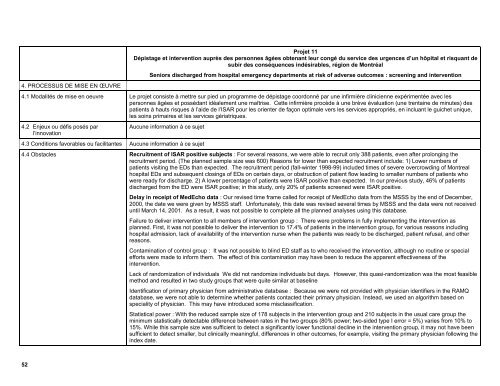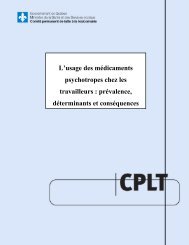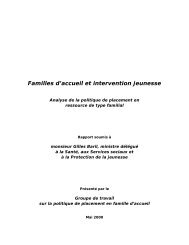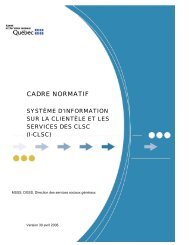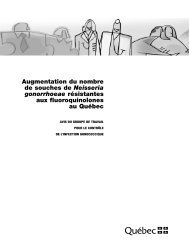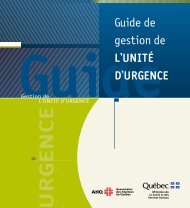De l'innovation au changement - Gouvernement du Québec
De l'innovation au changement - Gouvernement du Québec
De l'innovation au changement - Gouvernement du Québec
Create successful ePaper yourself
Turn your PDF publications into a flip-book with our unique Google optimized e-Paper software.
4. PROCESSUS DE MISE EN ŒUVRE<br />
Projet 11<br />
Dépistage et intervention <strong>au</strong>près des personnes âgées obtenant leur congé <strong>du</strong> service des urgences d’un hôpital et risquant de<br />
subir des conséquences indésirables, région de Montréal<br />
Seniors discharged from hospital emergency departments at risk of adverse outcomes : screening and intervention<br />
4.1 Modalités de mise en oeuvre Le projet consiste à mettre sur pied un programme de dépistage coordonné par une infirmière clinicienne expérimentée avec les<br />
personnes âgées et possédant idéalement une maîtrise. Cette infirmière procède à une brève évaluation (une trentaine de minutes) des<br />
patients à h<strong>au</strong>ts risques à l’aide de l’ISAR pour les orienter de façon optimale vers les services appropriés, en incluant le guichet unique,<br />
les soins primaires et les services gériatriques.<br />
4.2 Enjeux ou défis posés par<br />
l’innovation<br />
Aucune information à ce sujet<br />
4.3 Conditions favorables ou facilitantes Aucune information à ce sujet<br />
4.4 Obstacles Recruitment of ISAR positive subjects : For several reasons, we were able to recruit only 388 patients, even after prolonging the<br />
recruitment period. (The planned sample size was 600) Reasons for lower than expected recruitment include: 1) Lower numbers of<br />
patients visiting the EDs than expected. The recruitment period (fall-winter 1998-99) included times of severe overcrowding of Montreal<br />
hospital EDs and subsequent closings of EDs on certain days, or obstruction of patient flow leading to smaller numbers of patients who<br />
were ready for discharge. 2) A lower percentage of patients were ISAR positive than expected. In our previous study, 46% of patients<br />
discharged from the ED were ISAR positive; in this study, only 20% of patients screened were ISAR positive.<br />
<strong>De</strong>lay in receipt of MedEcho data : Our revised time frame called for receipt of MedEcho data from the MSSS by the end of <strong>De</strong>cember,<br />
2000, the date we were given by MSSS staff. Unfortunately, this date was revised several times by MSSS and the data were not received<br />
until March 14, 2001. As a result, it was not possible to complete all the planned analyses using this database.<br />
Failure to deliver intervention to all members of intervention group : There were problems in fully implementing the intervention as<br />
planned. First, it was not possible to deliver the intervention to 17.4% of patients in the intervention group, for various reasons including<br />
hospital admission, lack of availability of the intervention nurse when the patients was ready to be discharged, patient refusal, and other<br />
reasons.<br />
Contamination of control group : It was not possible to blind ED staff as to who received the intervention, although no routine or special<br />
efforts were made to inform them. The effect of this contamination may have been to re<strong>du</strong>ce the apparent effectiveness of the<br />
intervention.<br />
Lack of randomization of indivi<strong>du</strong>als We did not randomize indivi<strong>du</strong>als but days. However, this quasi-randomization was the most feasible<br />
method and resulted in two study groups that were quite similar at baseline<br />
Identification of primary physician from administrative database : Bec<strong>au</strong>se we were not provided with physician identifiers in the RAMQ<br />
database, we were not able to determine whether patients contacted their primary physician. Instead, we used an algorithm based on<br />
speciality of physician. This may have intro<strong>du</strong>ced some misclassification.<br />
Statistical power : With the re<strong>du</strong>ced sample size of 178 subjects in the intervention group and 210 subjects in the usual care group the<br />
minimum statistically detectable difference between rates in the two groups (80% power; two-sided type I error = 5%) varies from 10% to<br />
15%. While this sample size was sufficient to detect a significantly lower functional decline in the intervention group, it may not have been<br />
sufficient to detect smaller, but clinically meaningful, differences in other outcomes, for example, visiting the primary physician following the<br />
index date.<br />
52


